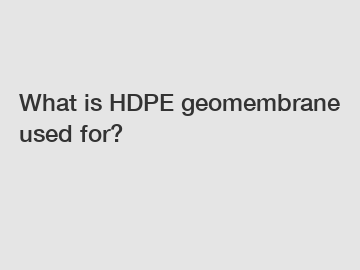What is HDPE geomembrane used for?
In various fields of civil engineering, the importance of geomembranes cannot be overstated. These high-density polyethylene (HDPE) liners play a vital role in containing and protecting critical structures and environments. Their exceptional properties make them a reliable solution for diverse applications, ranging from environmental protection to containment systems. In this blog, we will explore the fascinating world of HDPE geomembrane and uncover its versatile uses in today's engineering projects.
1. Environmental Protection.
One of the primary applications of HDPE geomembrane is environmental protection. Whether it's landfills, waste containment, or water reservoirs, geomembranes ensure the prevention of harmful substances from leaching into the environment. The impermeable nature of HDPE liners acts as a barrier, effectively safeguarding natural resources and ecosystems from contamination.

For instance, in landfill construction, HDPE geomembrane liners are used as a secondary containment system. These liners provide a reliable barrier to avoid the leakage of hazardous chemicals and pollutants into the ground, protecting groundwater sources from contamination.
2. Water Management.
With an increasing focus on water management, HDPE geomembrane has proven to be an invaluable asset in preventing water loss and ensuring efficient water storage. Geomembranes are widely used in the construction of reservoirs, ponds, and irrigation systems, providing resistance against seepage and evaporation.
The exceptional durability and flexibility of HDPE geomembrane allow for effective lining in large bodies of water without compromising structural integrity. By reducing water loss and maintaining water quality, HDPE liners contribute to sustainable water management, especially in regions prone to water scarcity.
3. Mining and Oil Industry.
In resource extraction industries, such as mining and oil exploration, HDPE geomembrane plays a crucial role in containing and managing hazardous materials. Geomembranes facilitate the safe disposal of mining tailings to prevent contamination of nearby water sources. These liners also line storage ponds and evaporation ponds, preventing the migration of potentially harmful substances.
Furthermore, HDPE geomembrane is utilized in oil and gas exploration to protect against oil spills and leaks. These liners act as a protective barrier, helping to minimize the environmental impact and maintain site integrity.
4. Construction and Building Industry.
Within the construction and building industry, HDPE geomembrane offers multiple applications. It is commonly used in the construction of tunnels and underground structures, acting as a waterproofing membrane to prevent water ingress and moisture damage. This ensures the structural integrity and longevity of the infrastructure.
Geomembranes are also utilized for land reclamation projects, where they provide an impermeable barrier between polluted soils and newly developed areas. This prevents migration of contaminants, allowing for the successful redevelopment of formerly contaminated land.
5. Agriculture and Aquaculture.
HDPE geomembrane finds significant use in agriculture and aquaculture. In fish farm applications, geomembranes are utilized in the construction of ponds, reservoirs, and tanks. By effectively sealing these aquatic environments, geomembranes prevent water seepage and maintain optimal water quality for fish growth.
In agriculture, HDPE geomembranes are employed for lining water canals and irrigation systems. They prevent water loss due to seepage, which is especially beneficial in regions experiencing high evaporation rates. This efficiently directs water to crops, reducing water usage and promoting sustainable agricultural practices.
Conclusion.
As evidenced by its broad range of applications, HDPE geomembrane has become an indispensable asset across various industries. Its exceptional properties, such as impermeability, flexibility, and durability, make it an ideal choice for environmental protection, water management, mining, construction, agriculture, and aquaculture projects. By preventing contamination and conserving resources, HDPE geomembrane plays a vital role in ensuring the sustainability and resilience of modern engineering endeavors.
Are you interested in learning more about geomembrane vs geotextile, difference between woven and non woven geotextile, concrete protective liners? Contact us today to secure an expert consultation!


